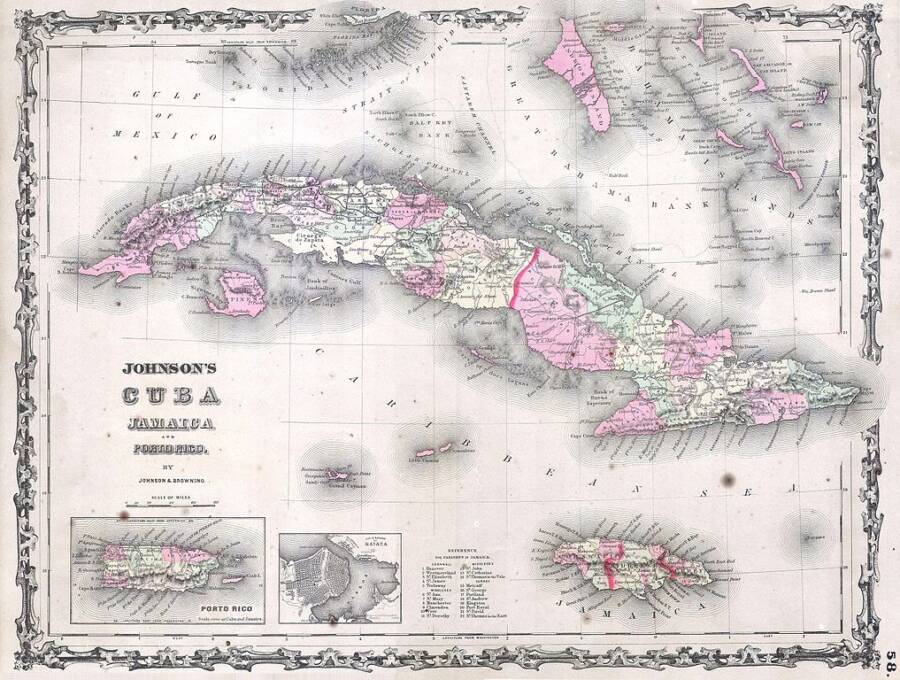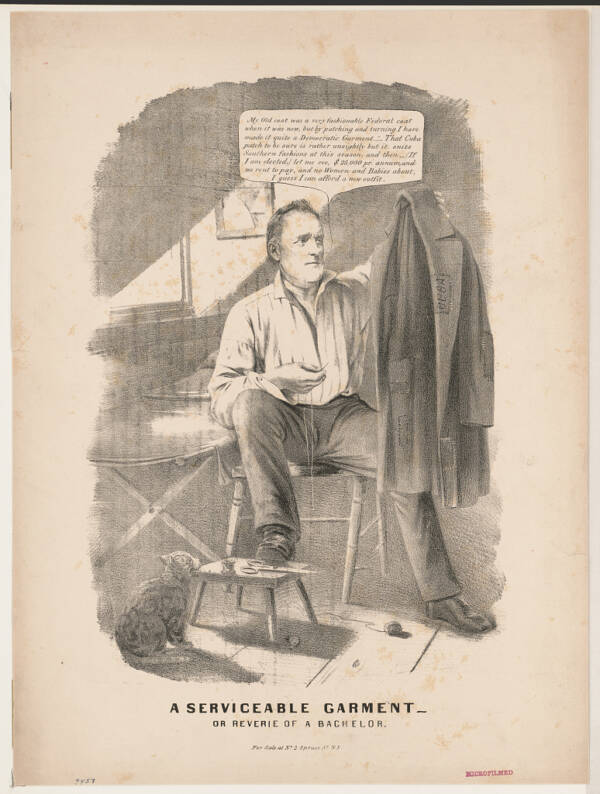In the years leading up to the Civil War, U.S. diplomats James Buchanan, John Y. Mason, and Pierre Soulé drafted a plot to wrest Cuba from Spain — in order to protect American slavery.

Nathaniel Currier/Library of CongressAn 1856 cartoon satirizing James Buchanan’s role in the Ostend Manifesto.
In 1858, Abraham Lincoln famously said, “A house divided against itself cannot stand.” At the time, the North and the South were deeply divided over the institution of slavery. The South supported the expansion of slavery outside its current bounds. The North wished to contain it — if not totally abolish it.
But the South had designs beyond the boundaries of the United States. They dreamed of “a Caribbean empire,” in the words of historian Robert May. Cuba specifically had been in slaveholders’ sights for quite some time.
When three U.S. diplomats met in Ostend, Belgium, in October 1854, they wrote a manifesto designed to convince the United States to purchase Cuba. And if Spain wouldn’t sell the island, they wanted to take it by force.
Instead, the Ostend Manifesto, as it became known, sparked controversy in both the U.S. and Europe — and ended up dooming Southern designs on Cuba for good.
The Argument For U.S. Expansion Into Cuba
In the 1850s, U.S. expansionists turned their attention to the Caribbean. There was already a long history of African slavery in the region, particularly on sugar plantations. Cuba was no exception, but there were rumors that Spain was planning to abolish the institution in the territory. Pro-slavery Americans grew concerned that this would spark revolts in the South.
The U.S. also wanted to protect the valuable port of New Orleans. If they had control of Cuba, they could better monitor who was coming into the Gulf of Mexico.

Library of CongressAn 1890 photograph of the main avenue in Ostend, Belgium.
According to Teaching American History, the U.S. had attempted to buy Cuba from Spain for $100 million in 1848, but Spain had rejected the offer. In 1854, America decided to try again.
U.S. Secretary of State William Marcy instructed three American diplomats to take a stab at a solution: James Buchanan, U.S. minister to Great Britain; John Mason, U.S. minister to France; and Pierre Soulé, U.S. minister to Spain.
A “full and free interchange of views” between the three was warranted, Marcy wrote. The men gathered in Ostend, Belgium, to put together their ideas, and they sent their work to Marcy on Oct. 18, 1854.
The Content Of The Ostend Manifesto
The main purpose of the Ostend Manifesto was to convince the United States to buy Cuba from Spain “with as little delay as possible.”
Buchanan, Mason, and Soulé believed that this would benefit both nations. And if Spain wouldn’t sell, they argued that the U.S. would “be justified in wresting it” from the country.
The trio made three major arguments to support their conclusions, interwoven throughout the course of the manifesto.
First, they argued that Cuba’s annexation to the U.S. would benefit global commerce. Nations like England and France would be able to improve their trade volume with Cuba.
Spain would also benefit from the influx of cash that the purchase of Cuba would bring. “Should Spain reject the present golden opportunity for developing her resources, and removing her financial embarrassments, it may never again return,” Buchanan, Mason, and Soulé explained.
Second, they claimed they wanted to end Spain’s “tyranny” over the island.
“Its inhabitants are now suffering under the worst of all possible governments — that of absolute despotism delegated by a distant power to irresponsible agents,” they wrote.

A. J. Johnson/Geographicus Rare Antique MapsAn 1861 map of Cuba.
In addition to the harm that the Spanish government had inflicted on the Cuban people, it had also taken adverse action against U.S. citizens and businesses, they claimed.
But the authors did not worry about Spain’s “despotism” for its own sake. Their third concern was that the oppression in Cuba would lead to another slave revolt like the Haitian Revolution — which would be about the worst possible outcome for slaveholding Southerners, per Encyclopedia Britannica.
“We should… be recreant to our duty, be unworthy of our gallant forefathers, and commit base treason against our posterity, should we permit Cuba to be Africanized and become a second St. Domingo, with all its attendant horrors to the white race, and suffer the flames to extend to our own neighboring shores, seriously to endanger or actually to consume the fair fabric of our Union,” they wrote.
Buchanan, Mason, and Soulé suggested that the U.S. pay Spain $120 million for Cuba — and take it by force if the Spanish refused to sell it.
“It is not improbable, therefore, that Cuba may be wrested from Spain by a successful revolution; and, in that event, she will lose both the island and the price we are willing now to pay for it,” they concluded.
Not everyone agreed with their sentiment, however.
How The Ostend Manifesto Sparked Controversy
Both Marcy and U.S. President Franklin Pierce were notably unhappy with the Ostend Manifesto. Marcy protested that the ministers had misinterpreted his instructions and worried that the publicity in Europe would harm the United States diplomatically.
The Ostend Manifesto’s publication by the House of Representatives in March 1855 sparked further fierce debate and discussion within the U.S. itself.
Anti-slavery publications had a field day arguing against the letter. Horace Greeley’s New York Tribune came out firmly against the manifesto. It called Buchanan, Mason, and Soulé the “Buccaneering Embassy” and the manifesto itself “the Manifesto of the Brigands,” according to Daniel J. Burge’s A Failed Vision of Empire.
The article also noted the harmful effects on U.S. diplomacy in Europe: “Everyone seems in haste to utter condemnation, and cast ridicule on the miserable abortion of the Ostend triumvirate,” it charged.
Scholars agree that the Ostend Manifesto hurt the Pierce administration in an era of fierce sectional controversy. Southerners believed that the publicity surrounding the Ostend Manifesto had permanently damaged their attempts to acquire Cuba. On the other hand, Northerners denounced the Pierce administration for its blatantly pro-Southern diplomatic stances.

Nathaniel Currier/Library of CongressAn 1856 political cartoon attacking Buchanan’s desire to purchase Cuba from Spain. The speech bubble above his head reads in part, “That Cuba patch to be sure is rather unsightly, but it suits Southern fashions at this season.”
The Ostend Manifesto resurfaced during the 1856 presidential election. According to Thought Co., it helped James Buchanan secure the Democratic nomination because Southerners agreed with the pro-slavery views put forth in the manifesto.
The nascent Republican Party strongly opposed the Ostend Manifesto and its role in Buchanan’s campaign. Its platform decried the “highwayman’s philosophy of might makes right” omnipresent throughout the letter.
But Buchanan won the presidency nonetheless, and newspapers sympathetic to the manifesto urged him to follow through with his words.
“Let him live up to the letter and the spirit of the Ostend letter; let him look to our interests in Cuba, which, by right of geography and physical necessity, should be ours,” urged The Indiana American newspaper in December 1856.
But Buchanan did not take up the paper’s charge. And Cuba would not again become a major issue in U.S. domestic discourse until the explosion of the U.S.S. Maine in Havana Harbor in 1898.
After learning about the Ostend Manifesto, read about why some historians believe that James Buchanan was America’s first gay president. Then, go inside Operation Northwoods, the U.S. military plot to start a war with Cuba.





